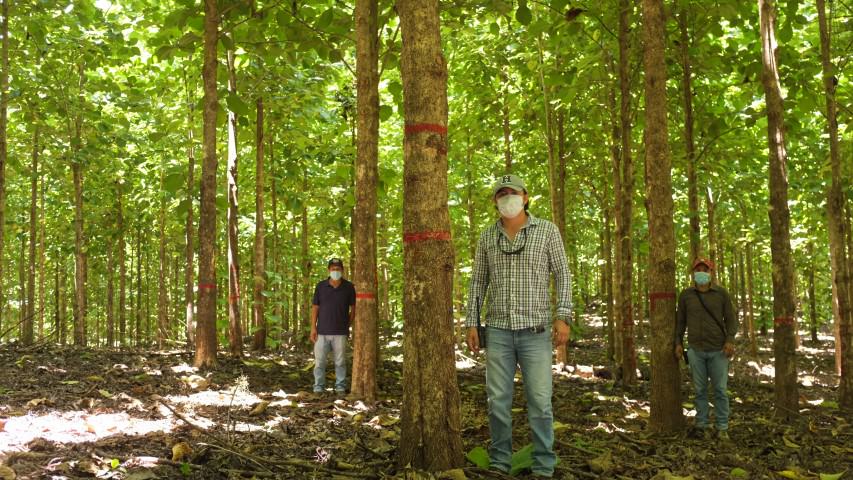Uncategorized @en
The multiple environmental benefits of forest plantations

Investment and economic development are generally thought to come at a cost to the environment, but companies that have invested in forest plantations are helping to halt the advance of the agricultural frontier while protecting soils, water sources. and biodiversity
Forest plantations are business alternatives that help curb the accelerated loss of natural forests. In addition to ensuring the sustainable production of wood to supply the industry, they provide a series of environmental benefits, which facilitate the recovery of degraded areas and help fight the effects of climate change. In areas such as the Nicaraguan Caribbean Coast, they also contribute to slow down the advance of the agricultural frontier.
“The main benefit is that by ensuring wood production through sustainable sources, forest plantations take pressure off natural forests. Because the more wood is produced in the plantations, the less it will be necessary to extract from the forests”, says Salvador Mayorga, president of the National Association of Reforesters (Confor).
Mayorga considers that in the case of the plantations established in the Autonomous Region of the North Caribbean Coast (RACCN), such as the MLR Forestal project, they are creating conditions that contribute to slowing down the advance of the agricultural frontier, with the establishment of plantations and the promotion of forestry activity in the area.
According to the study Commercial Forest Plantations in Nicaragua, by the Nicaraguan Foundation for Economic and Social Development (Funides), “deforestation mainly occurs due to changes in land use for growing food crops, and later these lands are use to grow pasture for cattle raising; by replacing the use of forest wood with plantation wood, you can contribute to the conservation (of the natural forest). In addition, combining plantations with silvopastoral and agroforestry systems can help improve yields and slow down the advance of the agricultural frontier ”.
According to the Humboldt Center, a large part of the forest plantations established in the RACCN are in areas where the agricultural frontier had already advanced and the use of the land had changed; Therefore, the establishment of these timber species has contributed to the recovery of the soil and the ecosystem in general.
Capturing carbon dioxide, the gas that causes the greenhouse effect
Another important benefit is that forest plantations capture carbon dioxide. This is a process in which trees capture carbon dioxide through photosynthesis; human activity, especially through industry, emits carbón dioxide into the atmosphere. The levels of this greenhouse gas have grown so much that they are causing the gradual increase in temperature on the planet, a phenomenon known as global warming.
The Kyoto Protocol – an international agreement promoted by the United Nations (UN) to curb climate change – turned carbon sequestration into a decontamination mechanism. By buying and selling carbon credits, the companies that carry out the activity receive economic incentives in return.
According to Mayorga, each cubic meter of wood captures three cubic meters of carbon dioxide from the atmosphere. In Nicaragua, forest plantations cover 35,000 hectares, 27,000 are forest plantations and 8,000 conservation areas, and two of the 16 companies associated with Confor have already entered the business of carbon credits.
Conservation areas, Mayorga explains, are established because not all the area destined to the cultivation of forest species is suitable for them. These are used for natural regeneration. Although in other cases, the establishment of these conservation areas is part of the policy of some companies, such as MLR Forestal.
Protect soils by providing forest cover
Forest plantations also protect soils through the permanent cover they provide, since the timber species that are planted require about 25 years to be cut. And once a hectare is cut, it is planted again and the process begins anew, guaranteeing the permanence of the ground cover. In addition to preventing soil erosion, this coverage also facilitates the infiltration of rainwater.
According to Víctor Campos, executive director of the Humboldt Center, plantations effectively provide ground cover. Campos explains that forest plantations are not natural forests, but they have relative advantages over other types of cover.
“For example, if you compare tree cover versus grass cover, there is undoubtedly a big difference. Or if the coverage provided by these plantations is compared with crops such as peanuts and other annual crops, there is a big difference. So, although economically a crop such as peanuts is much more profitable, in terms of tree or forest cover, the advantages provided by forest plantations are more effective, ” Campos explains.
In its report: The State of the World’s Forests 2020 FAO classifies forests into naturally regenerated and planted forests. In turn, the naturally regenerated ones are broken down into primary forests and other naturally regenerated forests; and the planted forests are divided into forest plantations and other planted forests.
Biodiversity also benefits
Another benefit is that the conservation areas that most projects include and the ´plantations themselves, favor the recovery of the area’s biodiversity and wildlife refuges.
“It is important to be clear that forest plantations are not natural forests, therefore, the level of biodiversity they promote is lower than that of a natural forest, because in many cases, and depending on the extension, they are forest monocultures”, Campos warns, “but it is definitely greater than that provided by other crops”. Particularly when these lands were degraded grounds before the plantation came along.
Forest plantations recover land degraded by other activities
“The use of forest plantations to rehabilitate degraded sites is well known in forestry practices today,” says the study Forest plantations: catalysts for conservation in Latin America, from the Food and Agriculture Organization of the United Nations, (FAO).
According to studies carried out by FAO in degraded sites, forest plantations can accumulate a large layer of organic matter and nutrients in the soil, in less time than plants of natural succession do. In addition, they play a role in the balance of insects, the improvement of landscape hydrology and nutrient cycling, and the optimization of runoff flow.
To take note:
- The National Assembly of Nicaragua passed the Conservation, Promotion and Development of the Forest Sector Act in 2003, that promoted the development of forestry projects. Since then, some 16 companies have stablished forest plantations in different areas of the country.
- Currently there are about 35 thousand hectares of forest plantations of various varieties in Nicaragua that have native and imported species, mainly teak, melina and African mahogany. In 2018, several plantations entered the thinning stage and the wood they produce is exported.
- According to FAO, in the world forest plantations cover about 131 million hectares; area that represents 3 percent of the world’s forest area.
Share




